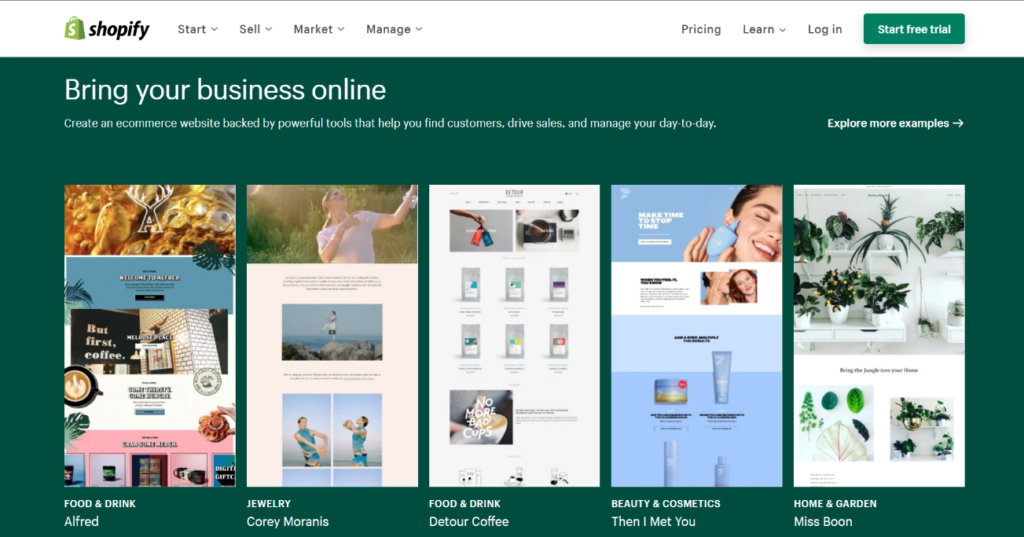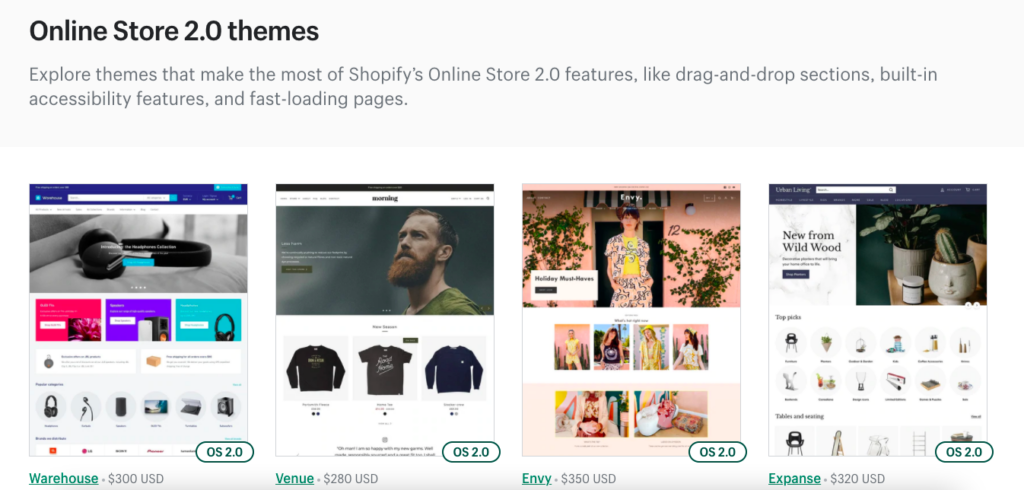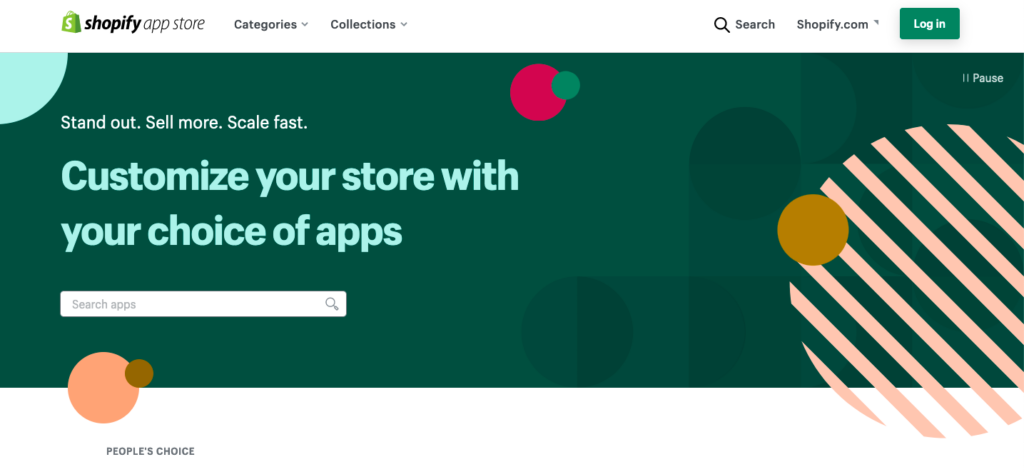Shopify is a simple, easy-to-use web application that lets you design and build your own ecommerce store. It’s one of the best and most popular ecommerce platforms on the market today, with millions of websites around the globe using it as their ecommerce site building platform as of 2025.
Whether you’re an experienced web developer or a total beginner, Shopify is the right fit for you. If you’re a beginner, Shopify lets you choose from a wide array of beautifully-designed templates and easily customize them to your store’s specifications.
On the other hand, if you’re more experienced and looking for even greater freedom of customization, Shopify also allows access to the HTML and CSS of your store, as well as to Liquid, Shopify’s templating language.
Shopify comes with a 14-day free trial, which is a great opportunity to try out different templates and make sure Shopify is the right fit for you.

You may be wondering if now is the best time to open a Shopify store, but the data couldn’t be clearer: online sales accounted for 19.2% of all retail sales in 2021, with consumers spending an incredible $871 billion in eCommerce transactions. This is an upward trend that’s expected to continue in 2022.
In other words, the best time to start a Shopify store was yesterday, the second best time is today!
For more on why Shopify is the best eCommerce builder on the market today, check out my full Shopify review.
What is the total cost of starting a Shopify Store?
Here’s how much does it cost to run a Shopify store approximately:
- Shopify plan – between $29 and $299 / month
- Shopify theme – between $150 and $350 (one-off cost)
- Shopify apps – between $5 and $20 / month per app
- Shopify email marketing – $0.001 USD per additional email
- Shopify POS – $89 / month per location
TL;DR: Shopify Basic costs $29 per month (and 2.9% + 30¢ per transaction). The Shopify plan is $79 per month (and 2.6% + 30¢ per transaction). Advanced Shopify is $299 per month (and 2.4% + 30¢ per transaction).
If you want to avoid extra payment processing fees, it’s a good idea to use Shopify Payments as your payment processor. Shopify Themes are a one-time cost of between $150-$350, and apps and POS hardware can further add to your total cost. However, POS hardware is only necessary if you have an in-person store location, and many apps come with free versions.
How Much Does Shopify Cost?

So you’ve decided to take the leap and open your Shopify store. Congratulations! Now you’re probably wondering how much is a Shopify store. The good news is that Shopify comes with a wide range of affordable plans to choose from.
However, there are also a few hidden costs beyond just the subscription cost that you’ll need to be aware of. Shopify also takes a percentage of each purchase conducted on your site, called a transaction cost.
If you want to avoid transaction fees, you need to install Shopify Payments as your payment processor instead of a third-party payment processor.
In addition to avoiding transaction fees, using Shopify Payments is a great way to make your store’s customer experience more seamless by fully integrating your checkout and eliminating the need to send your customers to a third-party payment service like Paypal.
Shopify Plans
Shopify Lite
- Subscription cost: $9/month
- Best for people looking to add a “buy” button to their preexisting website, or looking to sell in-person.
- You can’t build a website with Shopify Lite – it’s exclusively a payment processing software.
Shopify Basic
- Subscription cost: $29/month
- Transaction costs: 2.9% + 30¢
- Best for new eCommerce businesses that don’t often conduct in-person sales.
Shopify
- Subscription cost: $79/month
- Transaction costs: 2.6% + 30¢
- Best for growing businesses that are selling products online or in-person.
Advanced Shopify
- Subscription cost: $299/month
- Transaction costs: 2.4% + 30¢
- Best for quickly-scaling businesses that need advanced reporting and analysis features.
Shopify Plus
- Starts at $2000/month but requires a consultation and custom quote.
- Only for very large businesses looking to seamlessly integrate their online and in-person retail.
Note: In Shopify’s pricing model, transaction costs and credit card fees are not the same. While using Shopify Payments will eliminate transaction fees, you’ll still be charged a credit card fee.
This allows your Shopify site to accept the main credit card providers such as Visa and Mastercard as payment. In other words, transaction fees are avoidable. Credit card fees are not.
Shopify Themes

Shopify is famous for its free themes, a reputation which is well deserved. They offer 11 free themes, each of which can be customized into three different colors, meaning that they technically offer 33 visually distinct free themes.
Some of these free themes, such as Debut (Shopify’s default theme) and Simple, are amongst Shopify’s most popular templates. However, if you really want to give your store a unique, standout flair, it’s worth looking into the 70+ premium themes available in the Shopify Theme Store.
If searching through all these themes sounds like a daunting task, don’t worry: Shopify makes it easy to search themes by industry (such as Art and Entertainment and Home and Garden) or by collections (such as Selling internationally and Selling in-person).
So how much is a unique Shopify theme going to cost?
The price of Shopify themes ranges from $150-$350. This is a one-time cost, and after your initial purchase, all theme updates and support are free.
Considering all this, it’s well worth your money to invest in the theme that best suits your brand’s unique aesthetic and needs. Some of the most popular paid Shopify themes are Impulse ($320, 3 styles), Prestige ($300, 3 styles), and Symmetry ($300, 4 styles), but of course, their popularity doesn’t mean that these are necessarily the right fit for you.
The best way to find a template that best fits your shop is to take advantage of Shopify’s 14-day free trial. The free trial allows you to play around with customizing themes and is a great opportunity to ‘try before you buy.’

While you’re exploring, be sure to check out Shopify’s Online Store 2.0 themes, which have been upgraded for better accessibility, faster-loading pages, and easy drag-and-drop editing.
Shopify Apps

So, you’ve chosen the perfect theme for your online store and paid for it. What’s next? Shopify Apps!
Shopify Apps are a fantastic set of tools for customizing your store even further. Apps can allow your eCommerce site to perform a wide variety of functions, from connecting your site to popular social media channels to collecting and providing analysis of important sales data.
The three most popular apps currently sold in the Shopify App store are Facebook channel, Google channel, and Point of Sale (P.O.S).
Apps in the Shopify App Store are sorted into categories including store design, marketing, and shipping and delivery. While some of the more advanced analytical and customer service capabilities enabled by Shopify apps may seem unnecessary if you’re just getting started.
There are several must-have apps for eCommerce beginners that will help your store get off to a great start and make your life easier in the process:
- Facebook Channel. This app connects your store seamlessly with Facebook and Instagram and allows you to get the word out about your incredible products to a potentially unlimited audience. With so many products being sold on social media these days, this app is a must-have. Best of all, Facebook Channel is completely free to install and run.
- Instafeed – Instagram Feed. Similar to Facebook Channel, this app allows you to further integrate your online store with its dedicated Instagram account. Market and sell products through one of the world’s most popular social media platforms, all while growing your own base of followers. Instafeed has a free option, but if you’re looking for more features, you can check out Instafeed Pro ($4.99/month) and Instafeed Plus ($19.99/month).
- Referral Candy. If customers love your products, they’re likely to refer them to their friends and family members. This is obviously beneficial for your business, and setting up a rewards program for referrals can make it beneficial for your customers, too. Referral rewards programs are one of the best and most organic ways to increase your sales, and Referral Candy makes it incredibly easy. Featuring a simple, easy-to-use dashboard for monetizing and tracking referrals and an automatic rewards delivery system, it also integrates with other apps like Facebook and Google Analytics so you can keep track of your business’s stats.
- Plug In SEO. SEO, or Search Engine Operation, is one of the most critical tools for making sure your site has a good position in Google’s PageRank (the order in which Google places search results), and Plug In SEO is an app that ensures this for your Shopify site. It includes templates for meta titles and descriptions, keyword tools and suggestions, broken link detection and repair, and much more. Plug In SEO has a free plan that comes with unlimited SEO and speed problem checks, a broken link checker, and automatic email alerts and support. For even more features, check out Plug In SEO Plus ($20/month) or Plug In SEO Pro ($29.99/month).
- AfterShip Returns Center. No matter how fantastic your products are, you’re inevitably going to have to process a few returns. Thankfully, AfterShip Returns Center makes it hassle-free. Designed specifically for quickly growing Shopify stores, AfterShip Returns Center comes with an intuitive, user-friendly interface that makes returning items a breeze for your customers. A positive return experience can go a long way towards ensuring that customers return in the future.
On your side, AfterShip allows you to keep track of all return requests in one place. It even auto-calculates the refundable amount and offers the opportunity to generate a gift card.
Aftership comes with a free plan that includes most features, after which there are three paid tiers ranging from $9-$99/month, depending on your needs.
Shopify Email Marketing

Wondering how to best reach your customers and ensure further sales in the future? Shopify Email Marketing can help!
Shopify Email Marketing is Shopify’s built-in email platform. It automatically pulls your logos and store colors from your site, and you can further customize by choosing from a wide variety of templates and layout schemes.
Design is where Shopify consistently shines, and Shopify Email Marketing makes it easy to make your email marketing content as aesthetically unique as your site.
You can send emails from your site’s domain name and create and manage updates, marketing campaigns, and limited-time offers. Shopify’s clean, user-friendly interface allows you to easily track how many emails you’ve sent and even how much customer engagement your emails have gotten.
In addition to all its incredible features, Shopify Email also comes with a pretty unbeatable price. Every month, you can send up to 2,500 emails to your customers for free.
After that, you only have to pay for what you use: each additional 1,000 emails costs only $1, which translates to $0.001 per email. It really doesn’t get cheaper than that!
Shopify POS

In addition to being a great eCommerce website builder, Shopify also has its own POS system. This is especially great for stores that have both an online and in-person store, as it allows you to keep track of all your sales effortlessly, using one system.
Shopify POS Lite comes free with your eCommerce subscription plan, but it’s primarily intended for temporary stores such as pop-up locations or craft fairs. If you’re looking for a POS system with more features, you’ll want to upgrade to one of their paid options.
The cost of your POS subscription will be added to your monthly subscription cost. There are two versions, one free and one paid:
Shopify POS Lite
- Free (included with all Shopify plans)
- Includes mobile POS, customer profiles, and order and product management.
Shopify POS Pro
- $89 per month per location (added to the cost of your monthly subscription)
- Intended to be used in physical store locations.
- Includes unlimited store staff + staff roles and permissions, smart inventory management, unlimited registers, and in-store analytics.
- Included for free with a Shopify Plus subscription.

If you’re selling in person, you’ll need to invest in the necessary hardware to support your POS system. The hardware comes at an additional cost (between $29-$299), but it’s a one-time investment. If you’re selling online only, there’s no need for hardware and thus no additional cost.
Summary – How much does Shopify actually cost?
All in all, the amount you end up paying for your Shopify store depends a lot on what you want. Assuming you want to use Shopify to build a website, your monthly subscription cost will be anywhere from $29/month for Shopify Basic to $299/month for Advanced Shopify (not including Shopify Plus, which is its own thing).
Shopify has an incredible number of free resources, from free templates to free versions of most of its apps. In other words, aside from your monthly subscription, the amount you spend on your Shopify site could effectively be $0.
If you decide to pay for a template, it’ll cost between $150-$350, and apps and other installations can range from as little as $2/month to as much as $1,850/month (don’t panic – you probably don’t need this one!).
Investing in a POS system is similarly flexible. Shopify POS Lite comes free with your subscription, and may be enough for your store’s needs – especially if you’re not selling at in-person locations. If you need a system with more advanced features, Shopify POS Pro will add $89 per month, per location to your overall subscription price.
Shopify is known for its flexibility, and its pricing is no exception: it can be as cheap or as costly as you need, depending on the unique needs of your online shop.
